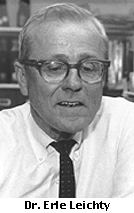
 |
|
Endowed Chairs for Dr. LaFleur and Dr. Leichty
One of the newest and one of the oldest of SAS's prestigious endowed chairs have been filled by current members of the faculty, Dean Samuel H. Preston has announced. Dr. William LaFleur is the inaugural E. Dale Saunders Professor in Japanese Studies, and Dr. Erle Leichty is the new holder of the 96-year-old Clark Research Professorship of Assyriology.
 Saunders Professor: Dr. LaFleur,
who joined the University in 1990 as associate professor of Japanese studies,
received his B.A. from Calvin College, his M.A. in comparative literature
from Michigan, and an M.A. and Ph.D. in Chicago's history of religions program.
He taught at Princeton and UCLA before coming to Penn.
Saunders Professor: Dr. LaFleur,
who joined the University in 1990 as associate professor of Japanese studies,
received his B.A. from Calvin College, his M.A. in comparative literature
from Michigan, and an M.A. and Ph.D. in Chicago's history of religions program.
He taught at Princeton and UCLA before coming to Penn.
Dr. LaFleur has also served on the Senate Executive Committee.
Dr. LaFleur's work revolves around the relationship between Buddhism and culture in Medieval Japan, and the relationship between religious and social issues in modern and contemporary Japan. It has been supported by the National Endowment for the Humanities and by a Sasakawa Grant for the study of philosophy in Modern Japan, and has led to awards such as the American Academy of Religion Prize and Japan's Watsuji Tetsurô Prize for scholarship. He was the first non-Japanese ever to win the latter prize.
Now head of the cross-disciplinary Japanese Program in SAS, he is presently in Japan working on a book on that country's debates on the propriety of organ transplants. His most recent work is Freaks and Philosophers: Minding the Body in Medieval Japan. Additional books include Mirror for the Moon: A Selection of Poems by Saigyô (1118-1190); The Karma of Words: Buddhism and the Literary Arts in Medieval Japan; Liquid Life: Abortion and Buddhism in Japan; and Buddhism: A Cultural Perspective. His reviews, articles, and essays have appeared in a range of publications from The Los Angeles Times to the Chanoyu Quarterly. In addition, Dr. LaFleur has published original poetry in such publications as Poetry L.A. and The Silverfish Review.
The Saunders chair is named for a distinguished scholar who was a member of the SAS faculty from 1955 until his death in 1995, at the age of 76. He was emeritus professor of Japanese when his generous bequest to establish this chair was finalized in 1993. Widely known for his writing and teaching in Japanese Buddhism, Classical Japanese Literature, and East Asian Civilization, he was the author of Mudra: A Study of Symbolic Gestures in Japanese Buddhist Sculpture, Mythologies of the Ancient World, and Japanese Buddhism.
 Clark Professor: Dr. Leichty joined
Penn in 1968 as asssociate professor of Oriental Studies, and is currently
curator of Akkadian Language and Literature and curator of tablet collections
at the University Museum. He is also a collaborator on the Penn Sumerian
Dictionary Project . His own books include volumes 6-8 of the Catalogue
of Babylonian Tablets in the British Museum and The Omen Series Summa
Izbu.
Clark Professor: Dr. Leichty joined
Penn in 1968 as asssociate professor of Oriental Studies, and is currently
curator of Akkadian Language and Literature and curator of tablet collections
at the University Museum. He is also a collaborator on the Penn Sumerian
Dictionary Project . His own books include volumes 6-8 of the Catalogue
of Babylonian Tablets in the British Museum and The Omen Series Summa
Izbu.
Dr. Leichty received his B.A. and M.A. from Michigan and his Ph.D. in Assyriology from Chicago. Winning a Guggenheim Fellowship among other honors, Dr. Leichty is a trustee of the Institute of Semitic Studies, and a member of the American Oriental Society, the Archaeological Institute of America, the British School of Archaeology in Iraq, the American Schools of Oriental Research, and Oriental Club of Philadelphia.
Even though the Clark Chair was established in 1902, Dr. Leichty is only its third holder. Dr. Åke Sjoberg was the Clark Professor from 1968 until his retirement in 1996, although he is still active as director of the Sumerian Dictionary Project, and before him Dr. Herman Hilprecht, professor of Semitic philology and archaeology, was the inaugural holder of the chair--whose initially specified "duty" was to decipher inscribed tablets and to study "all the antiquities in the possession of the Babylonian and General Semitic Section of Penn's Department of Archaeology." This research was intended to lead to purposes "useful to science, religion, history and society at large." The donors, Edward White Clark and Clarence H. Clark, were two prominent financiers of turn-of-the century Philadelphia who developed a deep devotion to Penn and to archaeology and ancient studies. Clarence served for a time as director of the Department of Archaeology at Penn, but also had an active career outside academia. Later in life he became president of the Horticultural Society of Philadelphia, a University Trustee, and a member of the Free Library board. Edward Clark was also a Trustee of the University who, inspired by a visit to Damascus in 1853, developed a lifelong interest in archaeology and helped to found the University Museum.
Almanac, Vol. 45, No. 24, March 16, 1999